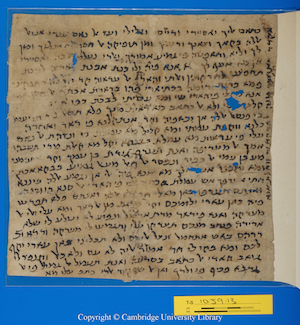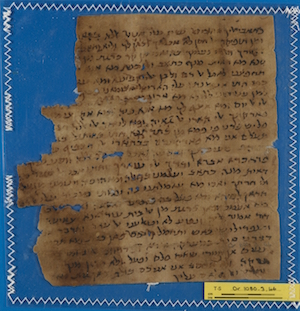'Protect me for (the tie of) blood and milk that is between us': T-S 10J9.13 and Or. 1080 3.46
by Oded Zinger
Readers of Goitein’s 3rd volume of Med. Soc. on ‘The Family’ may remember T-S 10J9.13, a “cry for help uttered by the luckless woman” with which Goitein concluded his discussion of marital strife “caused or aggravated by the interference of the husband’s family.” The story behind the letter stands out both for its intricate web of kinship ties, as well as in the extent of familial strife that it conveys. Goitein translated the greater part of the letter and offered a convincing reconstruction of the kinship relationships (although some problems linger).[1] At the heart of the story are two (estranged) sisters who married two brothers who were also their paternal cousins. The letter was written by Umm Sitt al-Nās, the daughter of one sister, who was married to the son of the other sister. The couple moved in together with the husband’s family which quickly brought about trouble. According to Umm Sitt al-Nās, her mother-in-law isolated her from other people. From the letter it appears that the writer’s mother (one of the two sisters) had gained a bad reputation, a fact that the writer’s mother-in-law did not fail to utilize against her daughter-in-law. Umm Sitt al-Nās writes that “The least she did was that she said to me: 'Go away and become like your notorious mother'.” To top that, she reports that “You know the noble character of your paternal cousin (i.e. her father-in-law). He suspected me with my older paternal cousin!”[2] Umm Sitt al-Nās wrote the letter to Abū l-Faḍl (Mevorakh b. Abraham) Ben Sabra, a well-known Maghrebi merchant, who Goitein suggests was her uncle and the brother of the two sisters. She informs him that she left home (“not of my choice”) and is living with a widow. She asks for a cape, a mantle and 20 dirhams so she can come to Abū l-Faḍl who is “charitable to strangers, how much more to your child.” Following Goitein’s discussion and translation, this fascinating letter has been discussed and analyzed in the literature on women in the Geniza.[3]
Cambridge University Library T-S 10J9.13 recto
Recently, I came across CUL Or. 1080 3.46, a faded and slightly torn letter written by the same woman and on the same matter to Abū ʿUmar Ben Sabra, who she calls “my brother.” However, from another Geniza document we learn that Mevorakh b. Abraham had two sons, one of them called Abū ʿUmar, and therefore it seems that this letter was written to the son of the recipient of T-S 10J9.13.[4] This, in fact, explains the use of the 2nd person plural in T-S 10J9.13: “you (pl.) know that I have no one but God and you, so do not neglect me, for my disgrace obligates you.” The existence of the two letters, dealing with the same matter, containing several related passages and, in fact, written even on pieces of paper of the same size allows us to look at how a single writer presents the same request to two different yet closely related people (the cape, mantle and 20 dirhams also make an appearance in this second letter). While the state of CUL Or. 1080 3.46 means that much time and work would be required to decipher and understand it in a satisfactory manner, the potential reward of such effort can be demonstrated through a single detail. In T-S 10J9.13, Umm Sitt al-Nās writes that “Even were I a daughter of a slave girl, you would protect me for my mother’s sake (lit. for the two eyes of my mother).”[5] In the letter to Abū ʿUmar she asks him to “protect me for the (tie of) blood and milk that is between us.” This statement practically proves Goitein’s suggestion that Abū l-Faḍl (the father of Abū ʿUmar) was related by blood to Umm Sitt al-Nās. More importantly, it shows us that Umm Sitt al-Nās felt she had a claim over Abū ʿUmar not only because of blood kinship, but also because they were breastfed by the same woman. Islamic law and Arab culture recognize a special bond between infants who were breastfed by the same woman.[6] This bond creates a legal impediment to marriage, allows social interaction across gender lines and imparts a social obligation. As far as I am aware, this is the first indication that such a notion was shared by the Jews who left us their records in the Geniza.[7]
Cambridge University Library Or. 1080 3.46
Research for this piece was supported by the Duke Center for Jewish Studies.
Footnotes
[1] Goitein, Med. Soc. 3:175-176.
[2] [itta]hamanī maʿa bin ʿammī al-kabīr - the nature of the suspicion is not explained in the letter. It is possible that this older cousin was an older brother of her husband or that he was Abū ʿUmar to whom the letter mentioned below was addressed.
[3] See, for example, Joel Kraemer, “Women Speak for Themselves,” in Stephan Reif, ed. The Cambridge Genizah Collections: Their Contents and Significance (Cambridge 2002), 210-11, and lrina Wandrey, “ʻDu weißt, dass ich niemanden habe außer Gott und Dir:ʼ Die Kategorie gender in Briefen und Dokumenten aus der Kairoer Geniza,” in Dialog der Disziplinen: Jüdische Studien und Literaturwissenschaft, ed. Eva Lezzi und Dorothea M. Salzer (Berlin 2009), 162-63.
[4] P. Heidelberg Heb. 28, ed. Ṣabīḥ ʿAodeh, “Eleventh Century Arabic Letters of Jewish Merchants from the Cairo Geniza” (Heb.) (PhD dissertation: Tel Aviv, 1992), doc. 19, pp. 271-273 (ʿAodeh cites the document as P. Heid. Arab 27, Goitein refers to this document as Heidelberg 915).
[5] Goitein explains the use of “the daughter of a slave girl”: “A ‘slave girl’ might have been a captive and, therefore, once a free woman. The daughter of a slave girl, that is, born in slavery, was a real slave” (Med. Soc. 3:464, note 76). However, it is also possible that Umm Sitt al-Nās hints here that as the daughter of a mother with a bad reputation, she is treated worse than a daughter of a slave woman.
[6] See Avner Giladi, Infants, Parents and Wet Nurses: Medieval Islamic Views on Breastfeeding and Their Social Implications (Leiden: Brill, 1999).
[7] The Geniza is quite reticent regarding wet nurses; see Goitein, Med. Soc. 1:127. For the opposite situation in Ashkenaz, see Simcha Emanuel, “The Christian Wet Nurse during the Middle Ages: Halakhah and History” (Heb.) Zion 73 (2008), 21-40. While in this letter the milk relationship appears as imparting a social obligation rather than an impediment to divorce, one may speculate whether this milk relationship may have prevented Umm Sitt al-Nās and Abū ʿUmar (who were obviously quite close) from marrying, thus leading Umm Sitt al-Nās to marry another cousin, a marriage which soon soured. Finally, according to the Karaite Benjamin al-Nahāwandī, milk relationship is an impediment to marriage, which raises the question whether our couple may have been Karaites. However, the Ben Sabra family is known from over forty documents, none of which suggest they were Karaites. Furthermore, Karaite family law forbids the marriage of two sisters to two brothers, as was the case between this couple’s parents; see Judith Olszowy-Schlanger, “Early Karaite Family Law,” in Karaite Judaism: A Guide to its History and Literary Sources, ed. Meira Polliack (Leiden: Brill, 2003), 280-82.
Cite this article
If you enjoyed this Fragment of the Month, you can find others here.
Contact us: genizah@lib.cam.ac.uk
The zoomable images are produced using Cloud Zoom, a jQueryimage zoom plugin:
Cloud Zoom, Copyright (c) 2010, R Cecco, www.professorcloud.com
Licensed under the MIT License


